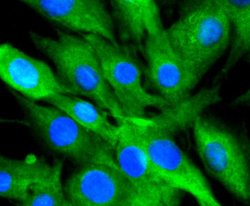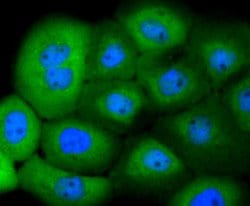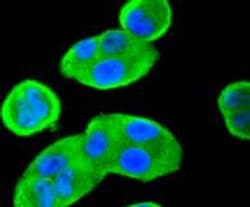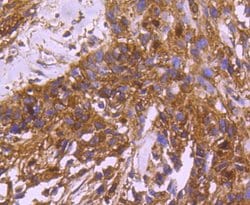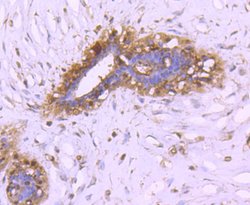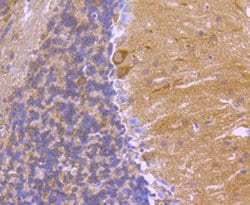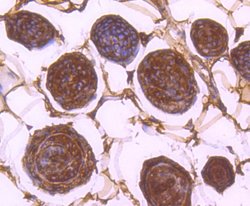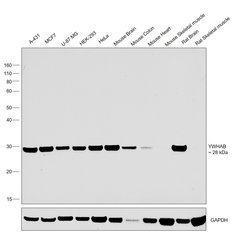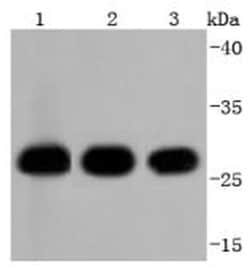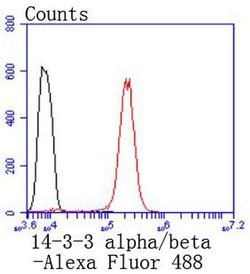Learn More
Invitrogen™ 14-3-3 beta Recombinant Rabbit Monoclonal Antibody (SD0837)
Rabbit Recombinant Monoclonal Antibody
Supplier: Invitrogen™ MA532419
Description
Recombinant rabbit monoclonal antibodies are produced using in vitro expression systems. The expression systems are developed by cloning in the specific antibody DNA sequences from immunoreactive rabbits. Then, individual clones are screened to select the best candidates for production. The advantages of using recombinant rabbit monoclonal antibodies include: better specificity and sensitivity, lot-to-lot consistency, animal origin-free formulations, and broader immunoreactivity to diverse targets due to larger rabbit immune repertoire.
14-3-3, a family of acidic and soluble proteins, highly conserved in amino acid sequences from yeast to mammals, is expressed in all eukaryotic cells. Seven isoforms(beta, gamma, epsilon, eta, zeta, sigma and tau/theta) encoded by seven distinct genes are identified in mammals and forms homo- and hetero- dimeric cup-shaped structures. As 14-3-3 is interacted with more than 100 binding partners, it regulates key proteins involved in various biological processes such as signal trans-duction, cell cycle, transcriptional control, cell proliferation, apoptosis, and ion channel physiology. Most 14-3-3 requires phosphorylation of serine or threonine residues in the target sequence. This protein is abundantly expressed in the brain and has been detected in the cerebrospinal fluid of patients with different neurological disorders.
Specifications
| 14-3-3 beta | |
| Recombinant Monoclonal | |
| 1 mg/mL | |
| TBS with 0.05% BSA, 40% Glycerol and 0.05% sodium azide; pH 7.4 | |
| P31946, P35213, Q9CQV8 | |
| YWHAB | |
| Synthetic peptide corresponding to C terminal Human 14-3-3 alpha + beta aa 197-246. | |
| 100 μL | |
| Primary | |
| Human, Mouse, Rat | |
| Antibody | |
| IgG |
| Flow Cytometry, Immunohistochemistry (Paraffin), Western Blot, Immunocytochemistry, Western Blot | |
| SD0837 | |
| Unconjugated | |
| YWHAB | |
| 1300003C17Rik; 14-3-3 alpha; 14-3-3 protein beta; 14-3-3 protein beta/alpha; 14-3-3 protein beta/alpha, N-terminally processed; 14-3-3 protein beta-subtype; 3-monooxygenase/tryptophan 5 monooxygenase activation protein beta polypeptide; brain protein 14-3-3, beta isoform; epididymis secretory protein Li 1; GW128; HEL-S-1; HS1; hypothetical protein GW128; KCIP 1; KCIP1; KCIP-1; Prepronerve growth factor RNH-1; protein 1054; Protein kinase C inhibitor protein 1; protein kinase C inhibitor protein-1; QccE-16215; RP1-148E22.1; tryosine 3-monooxygenase/tryptophan 5-monooxygenase activation protein beta polypeptide; tryosine 3-monooxygenase/tryptophan 5-monooxygenase activation protein gamma; tyrosine 3/tryptophan 5 -monooxygenase activation protein beta polypeptide; tyrosine 3/tryptophan 5 -monooxygenase activation protein, beta polypeptide; tyrosine 3-monooxgenase/tryptophan 5 monooxgenase activation protein beta polypeptide; tyrosine 3-monooxgenase/tryptophan 5 monooxgenase activation protein, beta polypeptide; tyrosine 3-monooxgenase/tryptophan 5-monooxgenase activation protein, beta polypeptide; tyrosine 3-monooxygenase/tryptophan 5-monooxygenase activation protein beta; tyrosine 3-monooxygenase/tryptophan 5-monooxygenase activation protein, alpha polypeptide; tyrosine 3-monooxygenase/tryptophan 5-monooxygenase activation protein, beta; tyrosine 3-monooxygenase/tryptophan 5-monooxygenase activation protein, beta polypeptide; unnamed protein product; YWHAA; Ywhab | |
| Rabbit | |
| Protein A | |
| RUO | |
| 54401, 56011, 7529 | |
| Store at 4°C short term. For long term storage, store at -20°C, avoiding freeze/thaw cycles. | |
| Liquid |
Safety and Handling
Your input is important to us. Please complete this form to provide feedback related to the content on this product.
